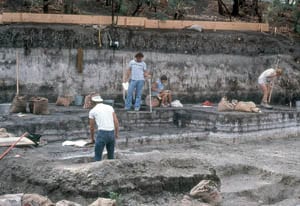An SMU archaeologist whose work centers on how people first came to inhabit North America has been elected a member of the National Academy of Sciences (NAS). David Meltzer, chair of SMU’s Department of Anthropology, has been elected a member of the NAS in recognition for his achievements in original scientific research.

Meltzer’s work looks at the origins, antiquity, and adaptations of the first Americans. Paleoindians colonized the North American continent at the end of the Ice Age. Meltzer focuses on how these hunter-gatherers met the challenges of moving across and adapting to the vast, ecologically diverse landscape of Late Glacial North America during a time of significant climate change.
Membership in the NAS is one of the highest honors given to a scientist or engineer in the United States.
The Henderson-Morrison Professor of Prehistory in Dedman College, Meltzer will be the third SMU professor to be inducted into the NAS. All three have come from the University’s highly regarded anthropology department. Meltzer is also director of QUEST Archaeological Research Program.
Meltzer was elected April 28 along with 71 other scientists, joining more than 2,000 active NAS members. More than 180 living Academy members have won Nobel Prizes. NAS members have included Albert Einstein, Robert Oppenheimer, Thomas Edison, Orville Wright, and Alexander Graham Bell.
“It’s really an honor to be in that wonderful company,” Meltzer said shortly after being notified of his selection by phone. “I am thrilled, excited, shocked, humbled. It’s a great day.” He said he was particularly touched that the NAS members who voted him in then passed a cell phone around to offer their individual congratulations.
“David Meltzer serves as the model of a professor whose research contributes to his discipline and our understanding of civilization, and who uses that knowledge to enliven his classroom,” said SMU President R. Gerald Turner. “His election to the NAS brings much-deserved recognition to Dedman College of Humanities and Sciences and honor to SMU.”
“One of the hallmarks of top universities is the election of their faculty to the prestigious National Academy of Sciences,” said Paul Ludden, university provost and vice president for academic affairs. “SMU is so proud of its top-tier anthropology faculty member, David Meltzer, for his election today.”
Meltzer’s archaeology and history research has been supported by grants from the National Geographic Society, the National Science Foundation, The Potts and Sibley Foundation and the Smithsonian Institution. In 1996, he received a research endowment from Joseph and Ruth Cramer to establish the Quest Archaeological Research Program at SMU, which will support in perpetuity research on the earliest occupants of North America.
His research has appeared in more than 130 publications, and Meltzer has written or edited half a dozen books, including “First People in a New World: Colonizing Ice Age Americans,” recently published by The University of California Press. He received his Ph.D in anthropology/archaeology from the University of Washington in Seattle and joined the faculty at SMU in 1984.
Two emeritus faculty members in SMU’s Anthropology Department are also NAS members: Lewis Binford was elected to the NAS in 2001 and Fred Wendorf was elected in 1987. Only an Academy member may submit formal nominations to the NAS, and supporting nomination materials and candidate lists remain confidential. The evaluation process occurs throughout the year, culminating in a final ballot at the Academy’s annual meeting in April.
The National Academy of Sciences is a private, nonprofit honorific society of distinguished scholars engaged in scientific and engineering research, dedicated to the furthering science and technology and to their use for the general welfare. Established in 1863, the National Academy of Sciences has served to “investigate, examine, experiment, and report upon any subject of science or art” whenever called upon to do so by any department of the government.
HOW I BECAME AN ARCHAEOLOGIST
David Meltzer said that although he had told it many times, this story first appeared in print in “The Dallas Morning News” on Dec. 24, 2001. Photo shows him (below) on his first day in the field in June 1971.

One June day after school let out (I had just finished 10th grade), my mother asked me what my plans were for the summer. I told her I hoped to slouch on the couch and watch television.
“That,” she announced, “isn’t good enough.” She showed me a piece in The Washington Post (our local newspaper) about excavations beginning in a week’s time in the nearby Shenandoah Valley, at the recently-discovered Thunderbird Paleoindian site.
“Would you like to join the group?”
“Sure,” I said, figuring at that late date the university’s plans must already be set and they couldn’t possibly want to take some snotty high school kid. I went back to watching My Favorite Martian.
Never underestimate your mother.
A day later she’d made fast friends with the administrative assistant at the office, who then talked the project director — Bill Gardner, of Catholic University — into taking me on. He wasn’t so keen on my being there, either! That was over 30 years ago. I went on to excavate for four consecutive seasons at the Thunderbird and nearby Fifty site, and I’ve been doing archaeology ever since.
I’m not sure why that newspaper story caught my mother’s eye, or why she thought her son would enjoy the experience. And I’m certain she didn’t imagine it would set me on a career. But I guess that’s just a mother’s gift, now, isn’t it?
Related links:
David J. Meltzer
NAS press release: Newly elected members
Department of Anthropology
Dedman College of Humanities and Sciences





